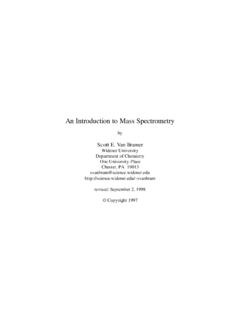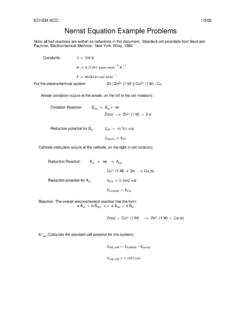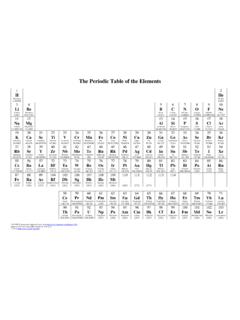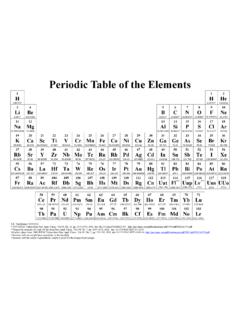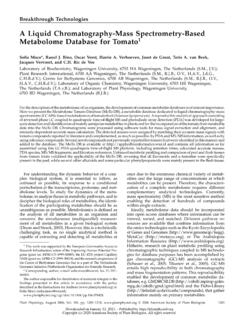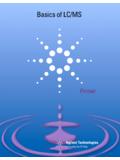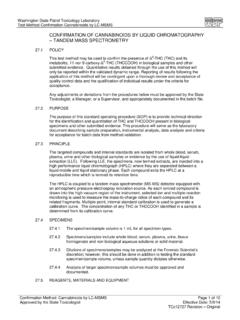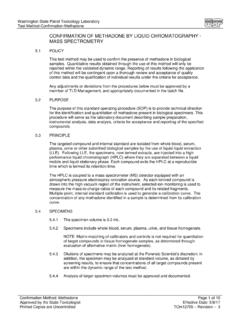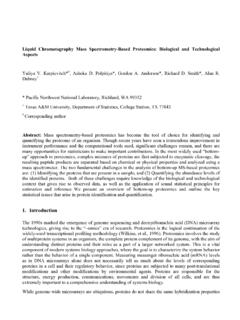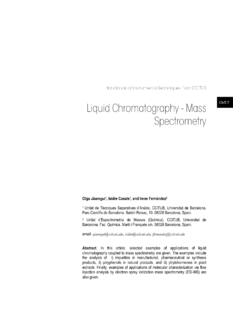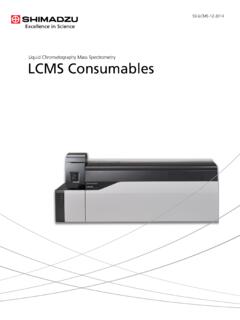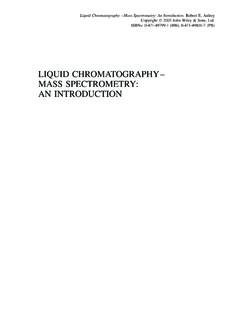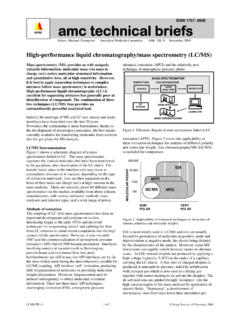Transcription of An Introduction to Mass Spectrometry
1 An Introduction to mass SpectrometrybyScott E. Van BramerWidener Universit yDep art ment of Chemist ryOne Universit y PlaceChester, PA t p ~svanbramrevised: Sep tember 2, 1998 Cop y right 1997 TABLE OF 4 SAM PLE Vapor Inlet ..5 Gas chromatography ..5 liquid chromatography ..6 Direct Insertion Ionization of Samp 9 Fast Atom Bombardment and Secondary Ion M ass Sp heric Pressure Ionization and Elect rosp ray atrix Assisted Laser Desorp 13 Other Ionization M #1 ..14M ASS Sector .. 17 Elect ric Sect or/Double Focusing mass ole Ion Cy clotron 22 Self-Test #2 ..23 DETECTORS .. 23VA CU U M SYST 24D A T A SYST olecular e 31 Exact mass .. OF PAPER QUESTIONS ..35 ANSWERS TO SELF-TEST QUESTIONS ..36 LITERATURE CITED ..37 Data SystemDetect or Ma ssAna lyzerVacuum SystemSourceRegionInletMore precisely mass Spectrometry determines the mass of a molecule.
2 *The mass to charge ratio (m/z) is used to describe ions observed in mass Spectrometry . By convention, m**is the numerical value for the mass of the ion and z is the numerical value for the charge of the ion. The unifiedatomic mass (u) and the elementary charge units (e) are used for these values. The unified atomic mass is defined as1/12 the mass of an atom of C. Older terms still in use but not accepted as SI units include the atomic mass unit12(amu) and the dalton (Da). The amu is no longer acceptable because there are conflicting definitions. The dalton isfrequently used for polymers, peptides and other large molecules. The elementary charge unit is defined as z is aninteger equal to the number of electrons lost (or gained for negative ions). For most experiments one electron is lostduring ionization so z is +1 and the m/z value is equivalent to the relative molecular mass of the ion.
3 Because theunified atomic mass and the charge number are pure numbers the mass -to-charge ratio is a number and does not haveany units. For calculations of the physical behavior of ions it is often necessary to use the actual mass (SI units ofkilogram) and charge (SI units of coulomb).Figu re 1. mass S pectrometer Block DiagramIN TRO D UC TIO N :M ass Sp ectrometry is a p owerful technique for identify ing unknowns, study ing molecularstructure, and p robing the fundament al p rincip les of chemist ry . Ap p licat ions of masssp ect romet ry include ident ify ing and quant it at ing p est icides in wat er samp les, it ident ify ingst eroids in at hlet es, det ermining met als at p p q (Part s Per Quadrillion) levels in water samp les,carbon-14 dating the Shroud of Turin using only 40 mg of samp le (1), looking for life on M ars, determining the mass of an Si atom with an accuracy of 70 p p t(2), and study ing the effect of28molecular collision angle on react ion ass sp ect romet ry is essent ially a t echnique for "weighing" molecules.
4 Obviously , t his*is not done with a conventional balance or scale. Inst ead, mass sp ect romet ry is based up on t hemot ion of a charged p art icle, called an ion, in an elect ric or magnet ic field. T he mass t o chargeratio (m/z) of the ion effects this motion. Since the charge of an electron is known, the mass to**charge rat io a measurement of an ion's mass . T y p ical mass sp ect romet ry research focuses on t heformat ion of gas p hase ions, t he chemist ry of ions, and ap p licat ions of mass sp ect romet ry .This p ap er covers the basics of mass sp ectrometry instrumentation and introduces theinterp retation of mass sp ectra. It is only an Introduction and interested readers are encouraged toconsult more sp ecializ ed books and journal articles for additional details. T he art icles and booksreferenced in this p ap er should be available at most college and universit y 1 is a block diagram t hat shows t he basic p art s of a mass sp ect romet er.
5 T he inlettransfers the samp le into the vacuum of the mass sp ectrometer. In the source region, neutralsamp le molecules are ioniz ed and t hen accelerat ed int o t he mass analy z er. T he mass analy z er ist he heart of t he mass sp ect romet er. T his sect ion sep arat es ions, eit her in sp ace or in t ime,according to their mass to charge ratio. After the ions are sep arated, they are detected and the5signal is transferred to a data sy stem for analy sis. All mass sp ectrometers also have a vacuumsy st em t o maint ain t he low p ressure, which is also called high vacuum, required for op eration. High vacuum minimiz es ion-molecule react ions, scat t ering, and neut raliz at ion of t he ions. Insome exp eriment s, t he p ressure in t he source region or a p art of the mass sp ectrometer isint ent ionally increased t o st udy t hese ion-molecule react ions.
6 Under normal op erat ion, however,any collisions will int erfere wit h t he analy AMPLE IN TRO D UC TIO N :T he select ion of a samp le inlet dep ends up on t he samp le and t he samp le mat rix. M ostionization techniques are designed for gas p hase molecules so t he inlet must t ransfer t he analy t eint o t he source as a gas p hase molecule. If t he analy t e is sufficient ly volat ile and t hermallyst able, a variet y of inlet s are available. Gases and samp les wit h high vap or p ressure areintroduced directly into the source region. Liquids and solids are usually heat ed t o increase t hevap or p ressure for analy sis. If the analy te is thermally labile (it decomp oses at hight emp erat ures) or if it does not have a sufficient vap or p ressure, t he samp le must be direct lyionized from the condensed p hase.
7 These direct ionization techniques require specialinstrumentation and are more difficult to use. However, they greatly extend the range ofcomp ounds that may be analy zed by mass sp ectrometry . Commercial inst rument s are availablethat use direct ionization techniques to routinely analy ze p roteins and p oly mers with molecularweights greater than 100,000 Vapor Inlet. The simp lest samp le Introduction method is a direct vap or inlet. Thegas p hase analy te is introduced directly into the source region of the mass sp ectrometer through aneedle valve. Pump out lines are usually included t o remove air from the samp le. This inletworks well for gases, liquids, or solids with a high vap or p ressure. Samp les with low vap orp ressure are heat ed t o increase t he vap or p ressure. Since t his inlet is limit ed t o st able compoundsand modest temp eratures, it only works for some samp les.
8 Gas chromatography . Gas chromatograp hy is p robably the most common technique forintroducing samp les into a mass sp ectrometer. Comp lex mixtures are routinely sep arated by gaschromatograp hy and mass sp ectrometry is used to identify and quantitate the individualcomp onent s. Several different int erface designs are used t o connect t hese t wo inst rument s. T hemost significant charact erist ics of t he inlet s are t he amount of GC carrier gas that enters the masssp ectrometer and the amount of analy te that enters the mass sp ectrometer. If a large flow of GCcarrier gas ent ers t he mass sp ect romet er it will increase t he p ressure in t he source region. M aint aining t he required source p ressure will require larger and more exp ensive vacuum p ump s. The amount of analy te that enters the mass sp ectrometer is imp ortant for imp roving the detectionlimit s of t he inst rument.
9 Ideally all t he analy t e and none of the GC carrier gas would enter thesource region. T he most common GC/M S int erface now uses a cap illary GC column. Since t he carriergas flow rat e is very small for these columns, the end of the capillary is insert ed direct ly int o t hesource region of the mass sp ectrometer. The entire flow from the GC enters the masssp ect romet er. Since cap illary columns are now very common, this inlet is widely used. However, wide bore capillaries and p acked GC columns have higher flow rat es. T his M is the molecular ion produced by removing a single electron to form a radical cation. M is the*+ molecule, is the charge of the cation, and is the remaining unpaired electron of the radical.+ Adduct ions are produced by a chemical reaction between an ion and a neutral molecule.
10 Many of these**reactions cause the addition of a proton (H ) to the molecule (M) and produce an adduct ion (MH ).+ +6significant ly increases t he p ressure in t he mass sp ect romet er. Several inlet designs are availableto reduce the gas flow into the source. The simp lest design sp lits the GC effluent so that only asmall p ort ion of t he t ot al flow ent ers t he mass sp ect romet er. Although this inlet reduces the gasload on the vacuum sy stem, it also reduces the amount of analy te. Effusive sep arators andmembrane inlet s are more select ive and t ransp ort a higher fract ion of t he analy t e int o t he sourceregion. Each of t hese methods has efficiency and resolut ion drawbacks but t hey are necessary forsome exp eriment chromatography . liquid chromatograp hy inlets are used to introduce thermallylabile compounds not easily sep arated by gas chromatograp hy.
